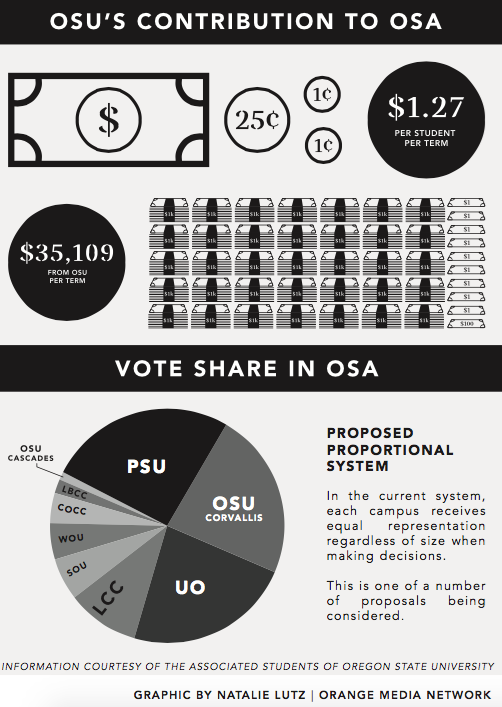ASOSU to vote on bill reshaping relationship with Oregon Student Association
April 2, 2018
Proposal includes proportional representation, new polling system.
This week the Associated Students of Oregon State University Congress will vote on legislation that would adjust how the student government negotiates membership in the Oregon Student Association. OSA, a statewide lobbying group, receives $105, 328 a year from OSU student fees.
The joint bill, introduced before spring break, would amend the ASOSU statues which currently require the student government to maintain their agreement with OSA every year. The revised version would give the negotiating team—the ASOSU President, Senate President pro-tempore and Speaker of the House— greater leverage by opening up the possibility for OSU to leave OSA. The legislation would also demand campuses receive proportional representation, departing from the current system where each member university and community college has an equal vote, regardless of size.
In addition to lobbying on behalf of college students at the state capital, OSA holds trainings on campuses and hosts conferences with hundreds of student attendees. These include the Oregon Students of Color Conference, which features workshops and lectures on social justice and political action, said the organization’s Executive Director Lamar Wise. OSA also puts on the Northwest Student Leadership Conference, which teaches leadership skills and helps connect students with internships and job opportunities after college.
“Students really appreciate the exposure to different ways of thinking about issues,” Wise said. “When I was a student and I went to my first Oregon Students of Color Conference, I learned a lot about the inequities within the correctional system.”
OSU has been one of OSA’s member schools since the organization was founded in 1975, said ASOSU Vice President Josh Kaufman. While ASOSU appropriates funds for OSA through student fees, approximately $1.27 per student per term, he explained his primary concern is the lack of representation for OSU student voices in the statewide group.
“We are not given a say within the organization proportional to the number of students we represent (which also determines the overall amount of dues we pay),” Kaufman said in an email. “OSA is supposed to represent the collective interests of over 130,000 students within the state of Oregon, but due to the voting structure within the organization, schools representing less than one fourth of that number could, in theory, call all of the shots.”
Senate President pro-tempore Katarina Rodak, one of the members of the OSA negotiation team, said every student on every member campus pays the same rate, meaning larger schools with more students pay more into the organization than smaller schools.
“All schools have equal seats on OSA boards with equal votes,” Rodak said in an email. “This causes the average Oregon student’s ability to have their input heard to be inversely dependent on the size of their school.”
At the same time as the proposal is being discussed, a committee with the ASOSU legislature is investigating OSA for alleged misappropriation of funds and offering unfair treatment to preferred candidates in student government elections. Kaufman said he intends to keep this issue and the legislation as separate as possible.
“We are going to release a report to Congress and the public by the end of this year, and leave it up to them to determine what, if any, action is warranted as a result of its findings,” Kaufman said in an email.
For Wise, OSA is more than an advocacy firm, making it difficult to put a price tag on the value it brings to students. He is aware of the investigation and welcomes questions.
“When student governments and campuses come together, they help to build power for each other,” Wise said. “OSA is a space for students to strategize and organize their peers around the issues that are affecting them, and make sure to turn them out in a way that is actionable.”
Regarding the discussion to adjust the relationship, Wise said a number of the smaller campuses and some larger universities around the state have concerns with OSU’s proposal.
“It is my job to make sure the organization stays together,” Wise said. “From what I can see, this proposal can mean the possibility of OSU pulling out of the organization if a big change is not made in the next few months. That is a big ask of a statewide organization.”
Another element of ASOSU’s proposal is new system for polling. OSA distributes an annual survey to students around the state to determine what issues it will focus on. In its current form, there is no option for students to dissent, Rodak said. This led to the issue of tuition and textbook affordability being nearly left off the survey.
“By having a third party polling service create the final survey based of the polls, we will be able to generate statistically significant and relevant data to show the Oregon legislature regarding Oregon student issues,” Rodak said in an email.
Despite the contention around these issues, the proposals are intended to strengthen OSU’s relationship with the other schools throughout the state through OSA, Rodak said.
“I think OSA has done a lot of great work and I do not want to undermine that, but I believe that they could be much more effective,” Rodak said.










































































































